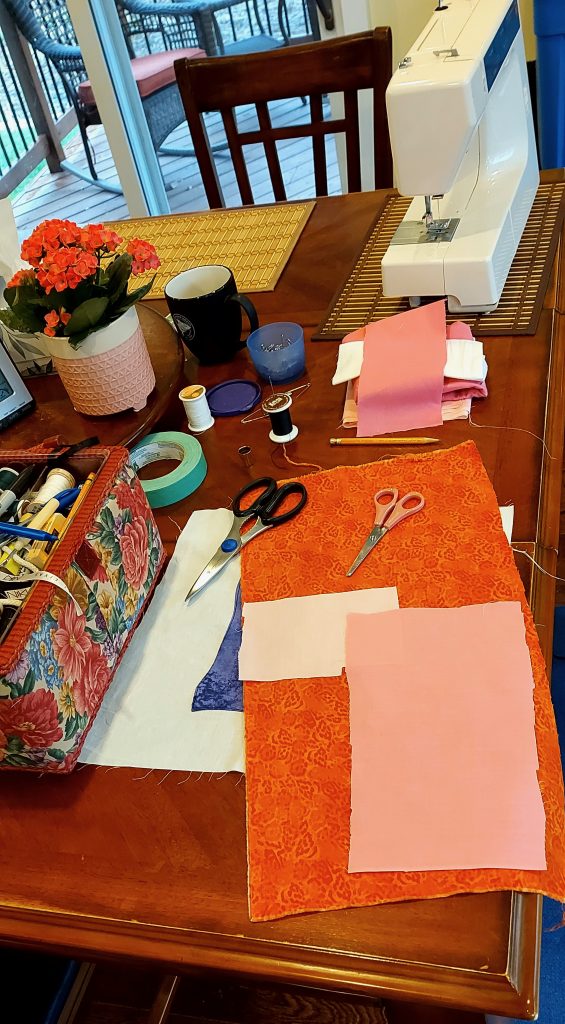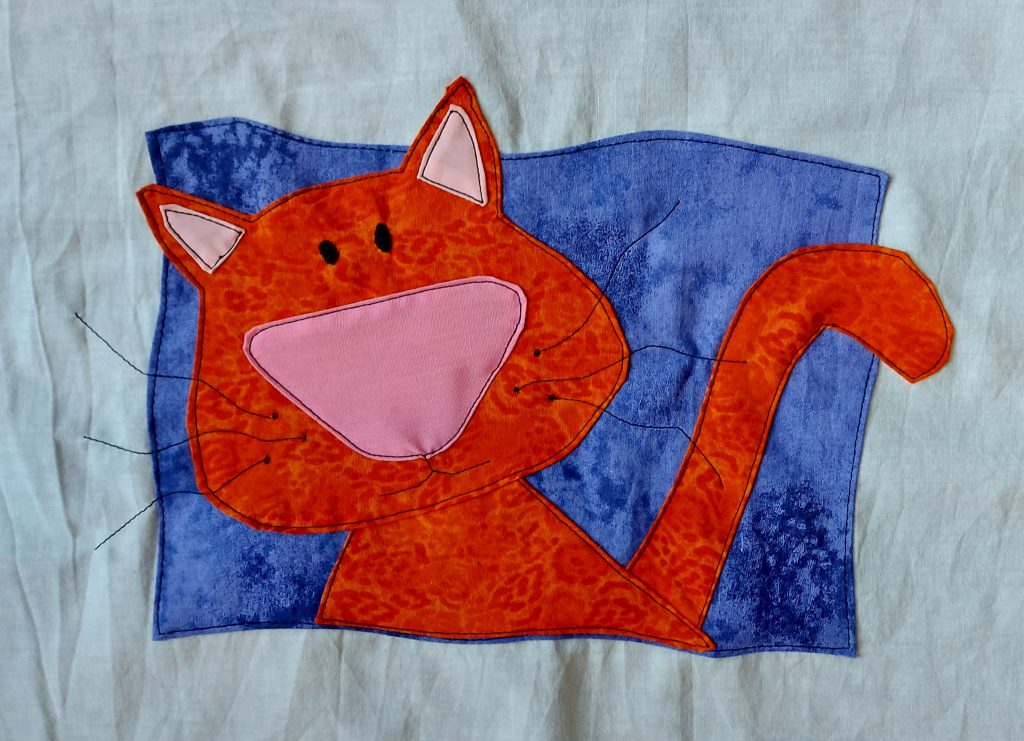
Often, writers have other creative interests besides writing short stories or novels. There are many pursuits to indulge in, such as painting, clay sculpture, embroidery, knitting, sewing, basket weaving, jewellery, photography, etc. I do many different activities, but this month, I concentrated on creating quilts.
As I pushed a hot iron across a square piece of white cotton material for the next quilt block, I couldn’t help but notice the similarity to a blank white page on my laptop or in my notebook. It struck me how similar being a novelist and a quiltmaker really are for me.
At first glance, a novel is made from words on pages bound together and printed into book form. A quilt is made from scraps of material and sewn together to produce a warm blanket. A book and a blanket are two different items, one hard and one soft, but both are created for you or someone else to enjoy. I thought about the parallels, and I couldn’t help but smile. Check them out below.
In the Beginning…
Novelist: You scratch a dozen ideas into a notebook with your favourite pen or pencil. You might add a few interesting characters, a tidbit of a plot, a theme, or some colossal conflict, and you need a solid setting. Example: In a cottage in the woods, two people fall in love but are stepsiblings. Yikes! Overall, there are endless possibilities available that it makes it hard to narrow them down for one story.
Quiltmaker: You scour books, magazines, and the internet for a quilt design that speaks to you. You pick the perfect colours, patterns, and images and place them side-by-side to test the overall effect. If you can’t find a design you like, you scratch a dozen creative ideas into your notebook and research the size of the quilt you need to cover the bed. You write down who the quilt might be for and the specific interests the person might have. Example: My granddaughter is almost two and has moved from the crib to a big bed. She loves animals and wants a new blanket. This narrows down the number of ideas to a dozen, until you come up with one idea.
Structure Selection…

Novelist: You examine how you would like to put your story together. Whether you would like to tell your story from beginning to end, move back and forth between past and present, or tell the story backward. There are many options to choose from when structuring a novel. To keep your reader interested, you must figure out a few plot elements such as inciting incident, rising action, climax, falling action, and resolution.
Quiltmaker: You create your design and decide how you will structure your quilt. Whether you use long strips of material, sew them all together, then move your long strips to create a dancing pattern, make individual blocks, sew them together with or without borders, or create a piece of art by mimicking a landscape or seascape. There are many options to piece your quilt together to make it pleasing to the eyes.
Jumping in with Both Feet…
Novelist: Start with a blank page and write new words. Most of the magic happens once your first draft is finished, and you go back and start editing. Of course, there are different ways to write and edit, chapter by chapter, 250 pages in one pass, or twenty pages at a time, etc.
Quiltmaker: Start with a blank piece of material and you add another piece of fabric until something begins to take shape. With a novel, you never know if the words will flow well together, and with a quilt, it is similar. You never know if your squares will appealingly connect to each other.
Threading Pieces Together…
Novelist: If things aren’t working quite right (I sometimes refer to this as the messy middle), you can move chapters around to see if you can build more suspense, or hide red herrings better, so your killer isn’t revealed too early. You thread information throughout the story to sprinkle it in a bit at a time. It makes your reader want to turn the pages faster because they need to keep reading to discover the answers. You thread in subplots and tiny characteristics of your characters that allow the reader to fall in love with the protagonist, and feel hatred for the antagonist. The threads make your novel memorable.

Quiltmaker: To join several pieces of material together, quilters use thread. Instead of moving chapters around like a novelist, a quiltmaker moves them around physically with their hands. You find ample floor space to place all your squares out and rearrange them until you find the best overall look. You separate the different colours, avoiding having two or three dark blue blocks beside each other. This is comparable to the pacing in a novel, where you wouldn’t place two or three fight scenes in a row. You would space them out, so it reads better, and people don’t get agitated by the violence. Of course, if your quilt is a colour-coordinating quilt that moves through the rainbow with different hues of material you might want blue against blue. This is a structural decision, just like the novel. If you are writing a Jack Reacher novel, you might have many fight scenes back to back. All of these decisions are made during the messy middle of the process. If you see the photos along the side of the page you will see the messy middle of building a block with a tabby cat. It hardly resembles a cat. They are oversized pieces overlapping, these include the quarter-inch seam most people don’t realize is needed. Quliters hide this, just like novelists cleverly hide their clues. The threads are what pull your blocks together into something recognizable, and keep them secure for the duration of the quilt’s life.
Think About the End User:
Novelist: Sometimes, it is handy to pick one person to write your novel for. Aim for someone specific. It doesn’t matter who it is, but it is easier to write the story if you think you are telling it to someone who wants to hear it. It helps you make hard decisions, like how scary it should be, how much detail to add, or how much explanation should be squeezed in. Should you avoid guns, abuse, or animal cruelty? Should you include sex, swearing, smoking, or drinking? Should you add fluffy dogs, yappy dogs, or dogs with a profession (guides for the blind or FBI electronic detection dogs)?
Quiltmakers: Usually, quiltmakers already have someone in mind for their quilt. If I created one for my oldest daughter, I might select an outdoor theme with camping. If I designed one for my middle child, I might add flowers, plants, or Harry Potter. My son might want a hockey or baseball-themed quilt. As I mentioned above, I’m making a quilt for my granddaughter, who moved from a crib to a big girl’s bed. She loves animals, so the quilt will be covered in animals that are found near Nana and Poppa’s house (and it will include a fluffy puppy).
In the End…

Novelist: Depending on where the novel is set, you should include enough details to immerse the reader into your story. They need to feel like they are right there with you, walking through the forest, attending a hockey game, or standing at the top of the Eiffel Tower. If you use too much description, you might throw the reader out of the story, which means they will put the book down and do something else.
Quiltmaker: For a quiltmaker, the details matter. Example: When making an animal quilt for a toddler, I need to use colours that represent real animals in nature, so it helps the pre-schooler know that it is a rabbit and not a frog, or a donkey and not a horse. If she can point to the animals, it will educate her. It will help her imagine stories about the animals, sing songs about them, and recognize them during our walks.
Bottom line…
Ultimately, being creative and unique is an opportunity to shine, whether writing a novel or creating a quilt for your loved one. Each writer can bring their own voice, point-of-view, opinions, emotions, skills, and talent to their writing projects. Each quiltmaker can do the same, using their imagination and skilled hands to produce a unique creation. These creations, your novels or your quilts, will be works of art cherished by generations to come made specifically by you.
My favourite 80-year-old aunt says, “If you haven’t bled on it, it must not be handmade.” Even experienced quiltmakers can’t go an hour without pricking themselves with a needle and drawing a drop or two of blood on the quilt. This is a sign of someone spending hours and hours making something for you. Please appreciate the thoughtfulness that went into something homemade. This goes for novel writers as well. If your heart is not bleeding all over the page by the time you finish writing the book, is it really even finished yet?
Lastly, my advice to you…
When life throws you scraps, make a quilt… or write a novel. Either way, they are bound by unique threads that only you could provide, which makes them memorable for years to come. Go ahead and be creative today, your future loved ones will love it long after you are gone from this earth.